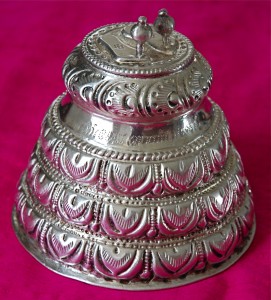
The shathari is an altar implement used primarily in many South Indian style temples. There is a famous temple in South India, just north of Chennai (Madras), that is dedicated to a particular form of Vishnu known as Shri Venkateshwara or Balaji for short. Modeled after this original Balaji temple, many cities in the West now have a Balaji Temple. Ordinarily most Hindus never see the shathari unless they visit this original Balaji temple in South India, but now that Balaji temples have proliferated around the world, the shathari is commonly seen.
At first look most people think that the shathari is some kind of a silver helmet that priests touch to the head of devotees, but in fact the helmet is a stand (pitha) for a small pair of shoes that are permanently mounted to the top. See the illustration above. The shoes are a symbol for the feet of God and so to be touched by the shathari is to have the feet of God placed on one’s head. This is a blessing.
The word shathari is made of two smaller words, “shatha” and “ari.” Shatha means “corruption,” “deceit” and “ego;” ari means “enemy.” So the shathari is literally the “enemy of deceit or ego,” which means that the feet of God are the enemy of bad things. In other words, the blessing of God destroys all bad things in the heart of the devotee. Ordinarily devotees will come for the divine seeing (darshana) of Balaji and in turn the priest will touch the shathari to the head of the devotee as a blessing.